OR/17/033 Achievements
| Baptie, B. 2017. Earthquake seismology 2016/2017 - BGS seismic monitoring and information service. British Geological Survey Internal Report, OR/17/033. |
Network performance
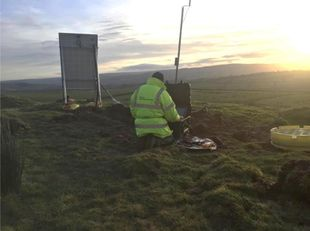
The network contains 44 broadband sensors with 24-bit acquisition which provide real-time data from across the UK. We continue to improve our near real-time data processing capability including the detection and location of significant seismic events in the UK and offshore area.
The network currently consists of 44 broadband sensors, 30 strong motion sensors and 29 short period sensors. In the last year the broadband station near Bath was decommissioned. Continuous data from all stations are transmitted in real-time to Edinburgh, where they are used for analysis and archived.
We have continued to incorporate data from seismic stations operated by European partner agencies into our near real-time processing to improve our detection capability in offshore areas. In particular, stations operated by the AWE Blacknest and the Dublin Institute of Advanced Studies, in Ireland, are vital for detection and location in a number of areas, e.g. the Irish Sea.
During the year, a total of 44 field trips were made to visit 123 sites around the UK taking a total of 241 person days. Of these visits, 41 were for maintenance or fault repair, four were to carry out site surveys for new stations, five were for installation of new stations and two were for decommissioning of old stations.
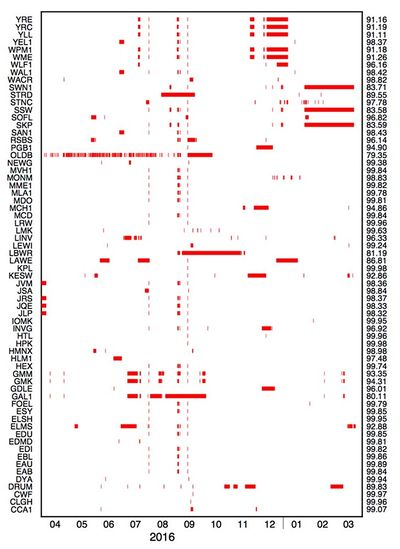
Continuous data from all our stations are archived within the BGS storage area network. The completeness of these data can be easily checked to gain an accurate picture of network performance. For 2016–2017, data are more than 95% complete 70% of the time, 90% complete 86% of the time, 85% complete 90% of the time and 80% complete 98% of the time, which is a significant improvement on the previous year when data was 80% complete for more than 90% of stations and more than 90% complete for over 60% of stations. Data losses result from failure of outstation hardware, communications problems, or failure of central data processing. The data acquisition is able to recover from short breaks in communications links to outstations by re-requesting missing packets of data from local data buffers, but failure of outstation hardware requires intervention by local operators or maintenance visits.
The worst performing stations were OLDB, Oldbury (79%), GAL1, Galloway (80%), LBWR, Ladybower (81%) and SWN1, Swindon (83%). In the case of Oldbury much of the loss of data resulted from a highly unreliable communications link. This was repaired in October 2016. Loss of data at the other three resulted from equipment failure that was concurrent with communications failures.
In addition, fewer than five stations were down 70% of the time and less than ten down 90% of the time. A snapshot of the impact that this has on the overall detection capability of the network can be obtained by calculating detection capability maps with and without the stations that were down at any time. For example, in September 2016, six stations (WACR, STRD, GAL1, LBWR, CCA1 and RSBS were down at the same time. This does not have a significant effect on overall detection capability except on the east coast of England around Suffolk and Norfolk and Lincolnshire.
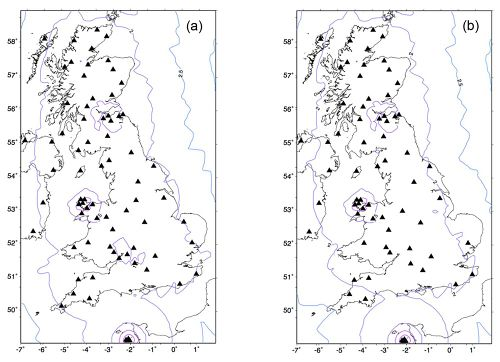
Network development
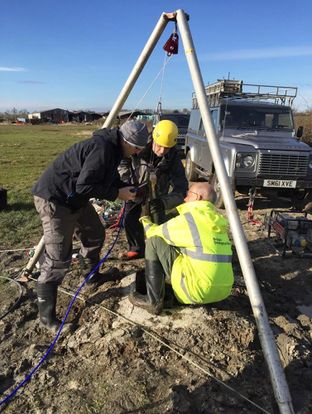
We are deploying sensors across the north of England as part of two projects: UKArray and Environmental Baseline Monitoring. Our aim is to provide improved earthquake catalogues, new, detailed models of the Earth’s crust under the UK, high resolution images of active fault zones, and near real-time information about both natural and man-made seismicity.
In 2015, BGS received over £500 000 from the Natural Environment Research Council (NERC) to purchase forty seismic sensors that could be deployed as an array at different locations across the UK, for a project called UKArray. The project is supported by the universities of Bristol, Edinburgh, Leicester and Liverpool. Our aim is to provide new, detailed models of the Earth’s crust under the UK, high resolution images of active fault zones, and near real-time information about both natural and man-made seismic activity including the low magnitude earthquakes commonly associated with industrial activity. The data will also be used to answer fundamental scientific questions about the shallow and deep Earth and to address important issues relating to the future use of the Earth’s sub-surface both as a source for sustainable energy and as a means of energy and waste storage.
In addition, we have installed a dense network of sensors in the Vale of Pickering, North Yorkshire (Ward et al., 2017[1]) for an environmental baseline monitoring project that started in 2015 and is funded by the Department for Business, Energy and Industrial Strategy (BEIS). The aim of this project is to collect data that will allow reliable characterisation of baseline levels of the natural seismic activity in the region. This will help discriminate between any natural seismicity and induced seismicity related to future shale gas exploration and production. It will also help to better understand the hazard and mitigate the risk of seismic activity induced by such industrial activities.
We have installed eleven stations in the Vale of Pickering and a further six stations in Lancashire in the Bowland Basin, which is another area of shale gas potential. A further eight stations have been installed more widely across the north of England and we plan to install a further 21 stations over the next year.
Continuous data from all installed stations are being transmitted in real-time to the BGS offices in Edinburgh and have been incorporated in the data acquisition and processing work flows used for the permanent UK network of real-time seismic stations operated by BGS. A number of detection algorithms are applied to the data in the region to detect possible events.
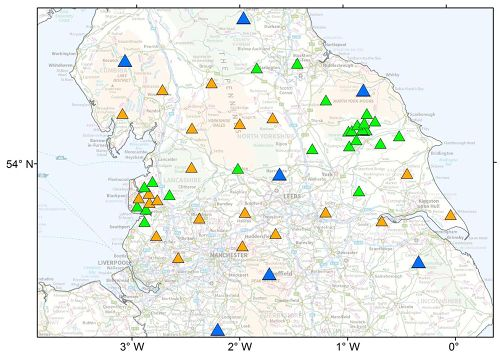
Information dissemination
It is a requirement of the Information Service that objective data and information be distributed rapidly and effectively after an event. Customer Group members have received notification by e-mail whenever an event was felt or heard by more than two individuals.
Notifications were issued for 17 UK events within the reporting period. Notifications for all local earthquakes were issued to Customer Group members within two hours of a member of the 24-hour on-call team being notified. The alerts include earthquake parameters, reports from members of the public, damage and background information. Seven of the alerts were for earthquakes on mainland Britain and a further eight were for earthquakes offshore in the waters around the British Isles. The two remaining alerts were for sonic events. No enquiries were received from Nuclear Power Stations in the period April 2016 to March 2017.
We continue to update the Seismology web pages. These web pages are directly linked to our earthquake database providing near real-time lists of significant earthquake activity, together with automatically generated pages for each event.
Our web pages also incorporate our automatic macroseismic processing system, which remains a key part of our response to felt events and is used to produce macroseismic maps for the seismology web pages that are updated in near real-time as data is contributed. We received 46 replies following the Colwyn Bay, North Wales, earthquake on 13 June 2016 (1.9 ML), 45 replies following a magnitude 2.3 ML earthquake near Liskeard, Cornwall, on 27 October 2016 and 51 replies following a magnitude 2.4 ML earthquake near Lephinmore, Argyll on 24 January 2017.
Data from the questionnaires are grouped by location into 5 x 5 km squares and an intensity value is assigned to each square, given that at least five responses are received from any square. Where fewer responses are received the intensity is either given as ‘felt’ or ‘not felt’ (which are defined as intensity 1 and 0, respectively).
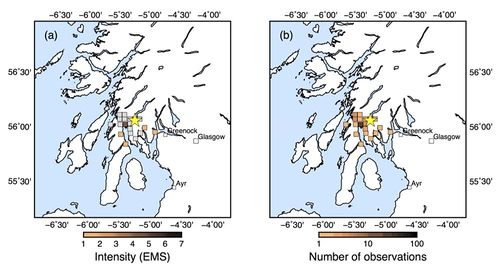
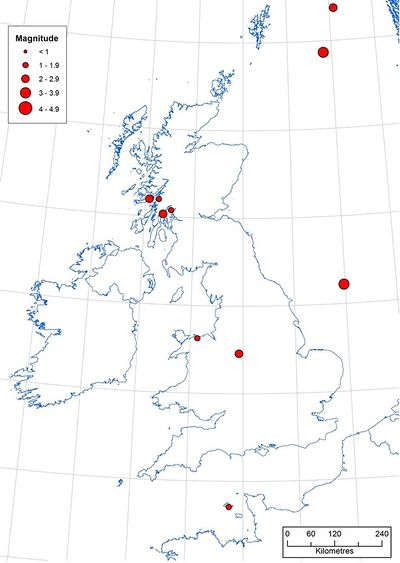
Communicating our science
An important part of the BGS mission is to provide accurate, impartial information in a timely fashion to our stakeholders, the public and the media. We promote understanding of Earth Sciences by engaging with schools through the UK School Seismology project and by creating dynamic web pages with background information and topical content.
The Seismology web pages are intended to provide earthquake information to the general public as quickly as possible. Earthquake lists, maps and specific pages are generated and updated automatically whenever a new event is entered in our database or when the parameters for an existing event are modified. We also have a database search page that allows users to search our database for basic earthquake parameters within a given geographic or magnitude range. We have also continued to provide displays of real-time data from most of our seismic stations that allow users to check activity or look for specific events. In addition, we continue to add event-specific content for significant earthquakes in the UK and around the world. These document the parameters of these events and provide information on the tectonic setting and background seismic activity in the region.
The seismology web site continues to be widely accessed, with over 62 988 visitors logged in the year (over 41.5 million hits).
We actively use Twitter, Facebook, Audioboo and YouTube to post earthquake alerts, provide news of new web pages, and showcase podcasts and videos of our seismologists. Facebook also offers a way for the public to engage with us by asking questions related to various postings.
The UK School Seismology Project (UKSSP) continues to grow and create new partnerships. The aim of the project is to develop specific resources for teaching and learning seismology in UK schools, including an inexpensive seismometer that is robust enough to be used in schools but still sensitive enough to record earthquakes from the other side of the world. These provide teachers and students with the excitement of being able to record their own scientific data and help students conduct investigations using their own data.
The BGS Earthquake Seismology team participated in an event called ‘Power of Our Planet’ at Our Dynamic Earth in Edinburgh in October 2016. This provided an opportunity for members of the public to meet a range of BGS scientists and explore a spectacular selection of Earth Science demonstrations and hands-on activities. The aim was to provide an understanding of the ways in which we rely on our planet to preserve our way of life, and the ways in which it can be threatened.
Football-Quakes is an outreach project that aimed to detect seismic disturbances during football matches at the Leicester City Football stadium. The project is a collaboration with Leicester University, SEIS-UK, and a city centre primary school, and resulted in a huge amount of publicity, both nationally and internationally.
Leicester University put the project forward as an exemplar of marketing and communications and it came first runner-up in the Guardian University awards 2017.
The MarsQuake education project is a UK Space Agency-funded initiative led by the British Geological Survey with partners from the National Space Academy, University of Leicester and University of Bristol. The project will develop a set of classroom activities and learning resources to support the mission.
The project will be part of the NASA INSIGHT Mission to Mars, and although the launch has been delayed from 2016 to 2018, the UK School Seismology team completed their UKSPACE agency funded project to develop the teaching resources for this project in January 2017. The resources include a booklet[2] and a set of classroom activities. Three thousand hard copies of the booklet have been printed ready to be distributed to teachers alongside the mission launch in 2018.
As part of the MarsQuake project, the UK school seismology team has also developed a new ultra-low cost seismic recording system based on a ‘build your own seismic sensor’ design (constructed from Lego) and a new low cost digitiser designed to work with the Raspberry Pi single board computer system.
BGS remains a principal point of contact for the public and the media for information on earthquakes and seismicity, both in the UK and overseas. During 2016–2017, at least 767 enquiries were answered. These were all logged using the BGS enquiries tracking database. Many of these were from the media, which often led to TV and radio interviews, particularly after significant earthquakes.
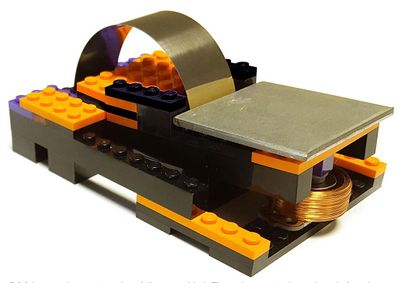
Collaboration and data exchange
Data from the seismograph network are freely available for academic use and we have continued to collaborate with researchers at academic institutes within the UK throughout the past year, as well as exchanging data with European and world agencies.
The UK Alliance for Disaster Research (UKADR) was launched in June 2016. BGS is one of the core partners and a founding member. The aim of UKADR is to bring together disaster researchers from all disciplines in the UK in order to aid representation of the research community at government level and to help facilitate the implementation of the Sendai Framework for Disaster Risk Reduction. The Alliance is independent and managed by voluntary contributions from the UK research community.
There is growing recognition of the role that science and scientists can play in reducing disaster risk and building resilience to geohazards, especially when working with people from other research disciplines and various stakeholders, including communities at risk. This often needs new ways of working, potentially in complex settings and difficult environments, to achieve positive and sustainable change.
Susanne Sargeant is continuing to work with researchers from a number of UK universities (including Cambridge, Oxford and Durham among others) and the Overseas Development Institute as a co-investigator on the Earthquakes without Frontiers (EwF) project. EwF is a transdisciplinary research project that aims to increase resilience to earthquakes and landslides in the Alpine-Himalayan Belt, focussing on Kazakhstan, Nepal and Bihar in northern India, and NE China. EwF is entering its final year and the collaboration between the BGS and the Institute of Seismology in Kazakhstan is continuing. Our activities focus on attenuation, magnitude determination and seismic hazard assessment.
Susanne is also working with researchers from the University of Edinburgh, University College London and Kings College London on a multi-disciplinary research project designed to improve the assessment of time-independent and time-dependent seismic hazard in Yunnan and Sichuan in China, and how this kind of information is used by decision makers.
Margarita Segou continues to work with researchers from leading EU and UK institutes in an effort to develop a protocol for sharing scientific information and expert advice in the aftermath of natural disasters. The research is part of the ARISTOTLE project, an All Risk Integrated System Towards Trans-boundary hoListic Early-warning.
BGS are working with the Istituto Nationale Geofisica e Vulcanologia (INGV), Italy, to help better understand deadly earthquake sequences such as the Central Italy sequence of 2016/2017. This has involved the deployment of temporary stations to collect essential data as well as collaboration on the underlying science of such sequences. An aligned project with researchers at the University of Edinburgh, funded by a NERC Urgency Grant, aims to develop testable forecast models for informed decision-making and the creation of a scientific protocol for stress-based modelling applicable to global seismicity.
Margarita Segou is a co-PI on the NERC funded research project REAR (Research Emergency Aftershock Response). The project brings together scientists and Arts-and-Humanities professionals to deliver protocols for the development, communication and dissemination of aftershock forecasts. Collaborating Institutes are University of Edinburgh University of Leeds and the Dublin Institute for Advanced Studies.
Margarita has also received a RCUK-DPRI Kyoto Research Grant to investigate earthquake triggering during the 2016 Kumamoto sequence. Funding supports a long-term visit in the Disaster Prevention Research Institute in Kyoto (Japan) for investigation of aftershock occurrence in Kumamoto region in Kyushu island.
Margarita is also a principal investigator of a proposal to form an international collaboration with UK (BGS, University of Edinburgh, Bristol), USA (University of Stanford, US Geological Survey, Lamont-Doherty Observatory Columbia University) and European (INGV, EPOS) institutes that will explore the processes driving the destructive earthquake sequence that struck the Central Apennines of Italy in 2016.
Ilaria Mosca continues to work within the EwF partnership to develop ground motion and seismic hazard models that can be used by stakeholders engaged in policy making and community-based risk reduction activities. Ilaria has also been working with the Kazakh Institute of Seismology providing support for the development of new national seismic hazard maps.
BGS data are exchanged with other agencies to help improve source parameters for regional and global earthquakes. Phase data are distributed to the (EMSC) to assist with relocation of regional earthquakes and rapid determination of source parameters. Phase data for global earthquakes are sent to both the National Earthquake Information Centre (NEIC) at the USGS and the International Seismological Centre (ISC). This year, data from 452 seismic events were sent. Data from the BGS broadband stations are transmitted to both ORFEUS, the regional data centre for broadband data, and IRIS (Incorporated Research in Seismology), the leading global data centre for waveform data, in near real-time.
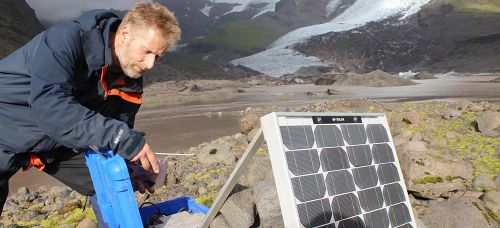
References
- ↑ Ward, R S, Smedley, P S, Allen, G, Baptie, B J, Daraktchieva, Z, Horleston, A, Jones, D G, Jordan, C J, Lewis, A, Lowry, D, Purvis, R M, and Rivett, M O. 2017. Environmental Baseline Monitoring Project. Phase II, final report. British Geological Survey, OR/17/049, 163pp.
- ↑ http://www.bgs.ac.uk/discoveringGeology/hazards/earthquakes/marsquake/home.html